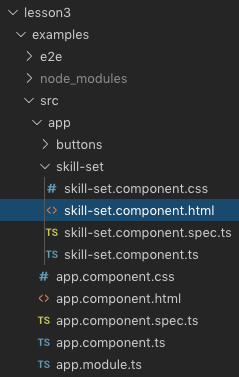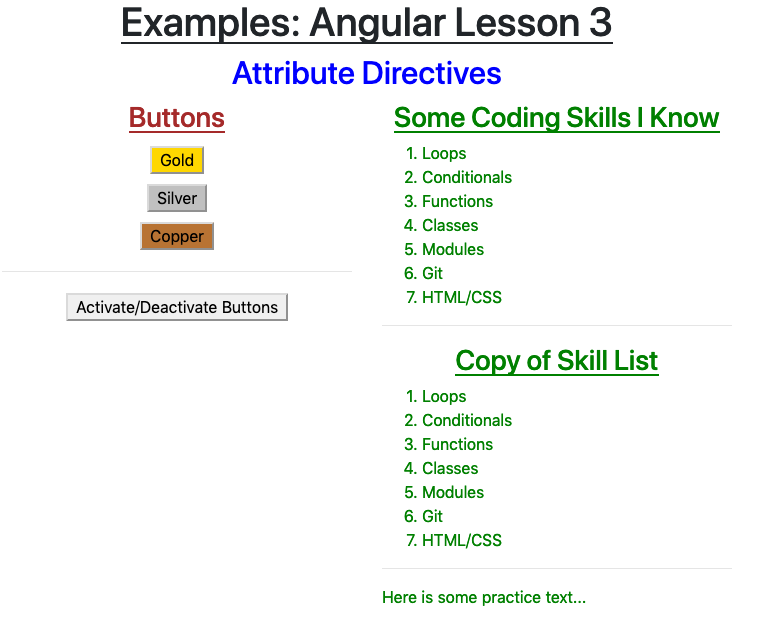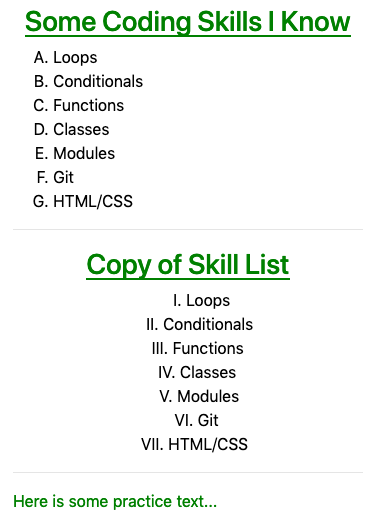31.3. Attribute Directives¶
In the previous two chapters, you learned about two of the three Angular directives---components and structural. You will now use data-binding to practice attribute directives. These change the appearance of a specific HTML element within the DOM.
31.3.1. Open the Lesson 3 Folder¶
Open VSCode and return to the angular-lc101-projects folder. Find
lesson3/examples/src/app in the sidebar and open the
skill-set.component.ts, skill-set.component.html, and
skill-set.component.css files.

Open the terminal panel and navigate to the lesson3 examples folder. Also
make sure that you are on the master branch.
$ git branch
* master
solutions
$ ls
lesson1 lesson2 lesson3
$ cd lesson3
$ ls
examples exercises
$ cd examples
Once you are in the folder, enter npm install in the terminal, then run
ng serve to launch the project.
You should see the following:

31.3.2. Update the Skill-Set Styling¶
Examine the code in the skill-set.component.css and
skill-set.component.html files:
Examples
CSS
1 2 3 4 5 6 7 8 | h3 {
text-align: center;
text-decoration: underline;
}
.skills {
color: green;
}
|
HTML
1 2 3 4 5 6 7 8 9 10 11 12 13 | <div class="skills">
<h3>{{listHeading}}</h3>
<ol>
<li *ngFor="let skill of skills">{{skill}}</li>
</ol>
<hr>
<h3>Copy of Skill List</h3>
<ol>
<li *ngFor="let skill of skills">{{skill}}</li>
</ol>
<hr>
<p>Here is some practice text...</p>
</div>
|
Right now, there is an awful lot of green on the page, which is set by the
skills class in the CSS file. Let's fix this with some attribute
directives.
31.3.2.1. Inline Styling¶
To change the color and bullet type of the first list element, we could override the CSS instructions with some inline code:
<ol style="color: black" type="A">
However, we can use what we learned about data-binding to replace these hard-coded styles with variables:
<ol [style.color]="alternateColor" [type]="bulletType">
Ideas to note:
Unlike the structural directives
*ngForand*ngIf, we can add more than one attribute directive to an HTML tag.The
styleattribute has different properties that can be assigned using dot notation. Examples includestyle.colorandstyle.background. For properties with two-word labels, liketext-align, the data-binding syntax accepts either hyphens or camel case (style.text-alignorstyle.textAlign).The variables
alternateColorandbulletTypeare assigned in theskill-set.component.tsfile.1 2 3 4 5 6 7 8 9 10 11 12
export class SkillSetComponent implements OnInit { listHeading: string = 'Some Coding Skills I Know'; skills: string[] = ['Loops', 'Conditionals', 'Functions', 'Classes', 'Modules', 'Git', 'HTML/CSS']; alternateColor: string = 'black'; bulletType: string = 'A'; changeColor: boolean = true; constructor() { } ngOnInit() { } }
NEAT! Reassigning the
alternateColorvariable in the.tsfile causes EVERY tag with[style.color]="alternateColor"to change color.
Try It
Change the values for the alternateColor and bulletType variables.
Save your work and refresh the web page to see the results.
Note that bulletType takes options of numbers (1), upper and lower
case letters (A, a), or upper and lower case Roman numerals (I,
i). For a detailed description of using the type attribute in an
ordered list, check out the
W3 schools documentation.
31.3.2.2. Changing Styles with Booleans¶
We can accomplish the same results by applying a class to the second ol
tag:
Add the following code to
skill-set.component.css:1 2 3 4 5
.ol-style { color: black; text-align: center; list-style-type: upper-roman; }
Note
The CSS property
list-style-typedefines the look of the list item markers, similar to theolelement'stypeattribute. The values available to the CSS property are different, however. You can find a full list at W3 schools.Next, modify line 8 in the starter HTML:
1 2 3 4 5 6 7 8 9 10 11 12 13
<div class="skills"> <h3>{{listHeading}}</h3> <ol [style.color]="alternateColor" [type]="bulletType"> <li *ngFor="let skill of skills">{{skill}}</li> </ol> <hr> <h3>Copy of Skill List</h3> <ol [class.ol-style]="changeColor"> <li *ngFor="let skill of skills">{{skill}}</li> </ol> <hr> <p>Here is some practice text...</p> </div>
After saving these updates, the skills list changes appearance:

Instead of setting
[class.ol-style]equal to a string, thechangeColorvariable is a boolean defined in theskill-set.component.tsfile. IfchangeColoristrue, Angular adds theol-styleclass of the tag. IfchangeColorisfalse, the class remains absent from the tag.
Try It
Set
changeColortofalseand verify that the second ordered list changes back to green, left-aligned, and numbered.Create a
p-styleclass in the CSS file and modify line 12 inskill-set.component.htmlto make the color and alignment of thepelement depend on!changeColor.
31.3.3. What About the Buttons?¶
Nice display of eagerness! We will deal with the buttons on the next page.
31.3.4. Check Your Understanding¶
The reversed attribute labels ordered lists from highest to lowest values
(9, 8, 7... instead of 1, 2, 3...). Unlike the class or style
attributes, reversed is not set equal to a string inside the HTML tag. Just
having it in the tag flips the numbering of the bullets.
<ol style="color: blue" reversed>
Question
How could we data-bind the reversed attribute in an ol tag? Indicate
ALL working options.
Bind the attribute to a variable that holds the string
"reversed"or"notReversed".Bind the attribute to a boolean variable set as
trueorfalse.Bind the attribute to a boolean statement like
variable1 > variable2.Bind the attribute to the empty string
"".Just put square brackets around
reversedand hope for the best.
